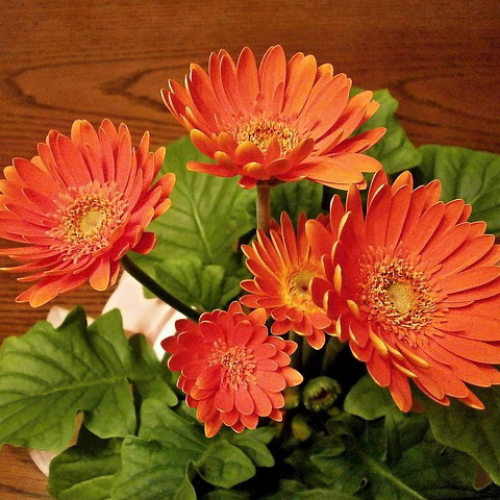Indoor plants Gerbera

Description
Characteristic Features of Gerbera
Gerbera is a genus of perennial herbs belonging to the sunflower family Asteraceae, or Compositae.
The genus comprises about 80 species. Some of them are found in South America, Australia, tropical Asia (India), China, Mongolia, Japan, and most of them in Africa (especially in the South Africa and Madagascar). The well-known daisies (Matricaria) are part of the same genus as Gerbera. Gerbera is commonly known as the Transvaal Daisy (Transvaal is one of the four provinces in the Republic of South Africa prior to 1994. The province covered 284,000 square kilometres between the Limpopo and the upper Waal.) There are also synonymic Latin names (Cleistanthium, Piloselloides).
All currently existing varieties of the domesticated Gerbera originate from only one ancestor, Jameson Gerbera (Gerbera jamesonii), first discovered in Transvaal in 1878. A decade later it came to Europe and was subjected to intensive cultivation much later than its popular counterparts. However, owing to the efforts of Dutch, Japanese, German, and American growers and experts it quickly gained worldwide fame and love as an ornamental, garden and indoor plant with a lovely capitulum. You can find Gerbera in all sorts of colours, except blue. Gerbera produces only one capitula but it can reach up to 15 centimetres across, and in some specially cultivated varieties even up to 30. The flowers grow on a long leafless stem. It can reach 60 centimetres tall. Undoubtedly, the plant was purposely created for cutting and commercial sale. Cut flowers live for no more than 36 hours but in the water they can live for 10-15 days, if you change water every day and if you have cut the bottom of the stem on a slant so that air does not get in (i.e. under water).
In fact, Gerbera Jameson differs from its hybrids by its compact height up to 0.5 metre (flowers 5-10 centimetres across), which makes it perfect for growing indoors. Dark green pubescent leaves with wavy edges grow 7-12 centimetres long. Multiple-petal capitula are scarlet, magenta, lemon yellow, plain yellow, or pink. The plant usually blooms for 2-3 months from the late summer to October. The blooming period is followed by the resting period until February.
The Secrets to Successfully Growing Gerbera
Gerbera can tolerate and grows well in direct sunlight. However, gardeners traditionally assume that the best summer temperature for Gerbera is only 20 ° C.
The plant loves light, warmth, and fresh air. In line with these preferences, select a very bright and warm place in the house that can be easily ventilated. Make sure there are no drafts. If possible, move the pot with Transvaal Daisy to the loggia, balcony, or garden for the spring and summer. You can even replant Gerbera in the open ground. Move back indoors before the night temperature drops to 8-10 ° C. Before the beginning of winter thin out the leaves to ensure enough light. During the resting period, keep the plant in the lightest area of the room. You might have to provide supplemental lighting for Gerbera in the winter. The best winter temperature ranges from 12 to 18 ° C.
Water moderately and avoid overwatering, especially in the winter.
Gerbera, in general, tolerates high humidity, if the area is sufficiently ventilated. However, do not mist the plant. Instead, place the plant on a tray filled with wet sand, expanded clay or (in extreme cases) medium-sized pebbles.
From March to October, add fertilizer for flowering plants every time you water the plant. Use ½ of the recommended strength.
Repot Gerbera in the spring (March-April) every year. Prepare lightweight fertile slightly acidic (pH 5-5.5) or neutral (pH 6-7) soil by mixing 1 part leaf mold, 1 part peat, 1 part sand, and 1 part shredded pine bark. Do not add compost and/or fresh humus as Gerbera does not tolerate them. The pot should be large and well-drained.
Propagate Gerbera by division or seeds.
Gerbera does not need pruning. Remove dead blooms promptly.
Potential Problems
If Gerbera is placed in direct sunlight, leaf colour can fade. Protect the plant from direct sunlight at midday.
If the plant starts to fade, gets leggy and becomes less attractive, this indicates insufficient light and/or a lack of nutrients.
The plant you purchased can grow from a dwarf into a giant when the action of retardants (special substances that growers use to help to slow down and limit growth) weakens or ceases.
Unfortunately, Gerbera is susceptible to various fungal diseases (such as powdery mildew, grey mold, etc.) caused by air stagnation (humidity plus poor ventilation) and clogged soil.
The Transvaal beauty can be affected by whiteflies, spider mites, aphids, and scale insects.







 305
305








